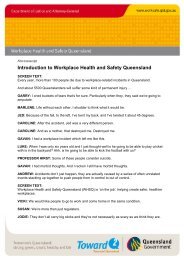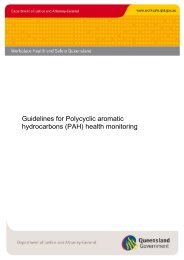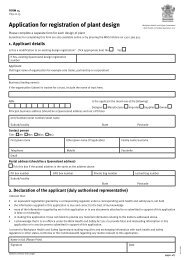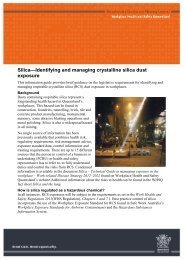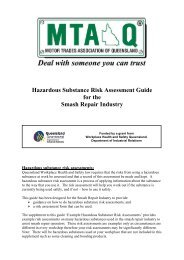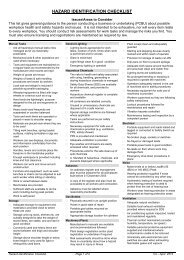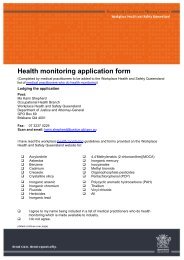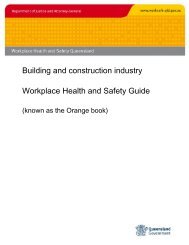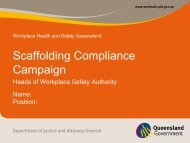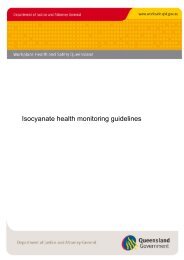A guide to the Dangerous Goods Safety Management Act 2001
A guide to the Dangerous Goods Safety Management Act 2001
A guide to the Dangerous Goods Safety Management Act 2001
Create successful ePaper yourself
Turn your PDF publications into a flip-book with our unique Google optimized e-Paper software.
In consultation with employees, a Systematic Risk Assessment must be completed <strong>to</strong>:<br />
• identify hazards that may cause a major accident;<br />
• assess <strong>the</strong> likelihood and impacts of a major accident; and<br />
• assess <strong>the</strong> overall risk from <strong>the</strong> MHF <strong>to</strong> people, property and <strong>the</strong> environment.<br />
The risk assessment must also refer <strong>to</strong> <strong>the</strong> management strategies which have been implemented <strong>to</strong> minimise<br />
and control <strong>the</strong> overall risk.<br />
The risk assessment must be reviewed and updated before <strong>the</strong> implementation of any modification which significantly<br />
alters <strong>the</strong> risk. This process must include consultation with employees.<br />
The <strong>Act</strong> also requires that occupiers assess <strong>the</strong> risk <strong>to</strong> <strong>the</strong>ir employees, o<strong>the</strong>r people, and <strong>the</strong>mselves from<br />
dangerous goods at <strong>the</strong> facility, and put in place all work practices needed <strong>to</strong> comply with <strong>the</strong> legislation.<br />
5.4 Emergency Plans and Procedures<br />
Emergency plans and procedures must be established, maintained, documented, reviewed and updated at least<br />
every 5 years in consultation with employees, neighbours and <strong>the</strong> emergency services.<br />
These plans must include strategies <strong>to</strong>:<br />
• contain and control a major accident <strong>to</strong> minimise off-site impacts; and<br />
• protect people, property and <strong>the</strong> environment in <strong>the</strong> event of a major accident.<br />
5.5 Education and Training of Employees<br />
The occupier is required <strong>to</strong> provide appropriate training <strong>to</strong> all staff at <strong>the</strong> facility so that <strong>the</strong>y can carry out<br />
<strong>the</strong>ir roles and duties safely.<br />
The training program must be prepared following consultation with employees and must:<br />
• provide appropriate induction, information, supervision, education, and training <strong>to</strong> enable all<br />
people at <strong>the</strong> location <strong>to</strong> carry out <strong>the</strong>ir roles and duties safely;<br />
• establish and maintain standards of competency;<br />
• be reviewed and conducted as often as necessary <strong>to</strong> maintain that competency; and<br />
• be undertaken before any modification is implemented which alters <strong>the</strong> risk associated with<br />
<strong>the</strong> facility.<br />
Records of training programs, attendance and competency levels must be maintained.<br />
5.6 <strong>Safety</strong> <strong>Management</strong> Systems<br />
The occupier is required <strong>to</strong> develop, implement, maintain, review and update a documented, comprehensive,<br />
integrated system for managing safety at <strong>the</strong> facility.<br />
12





